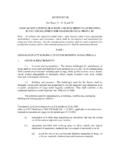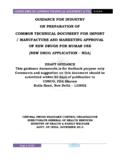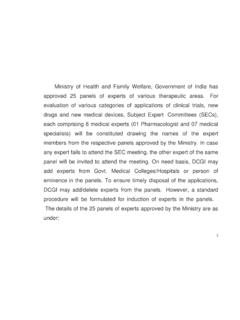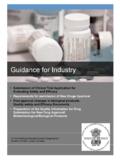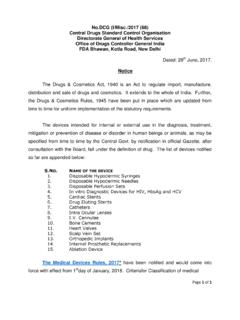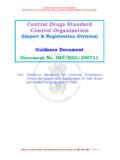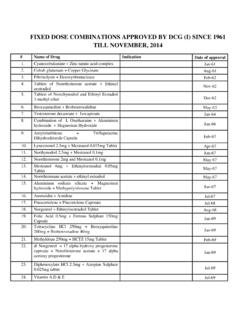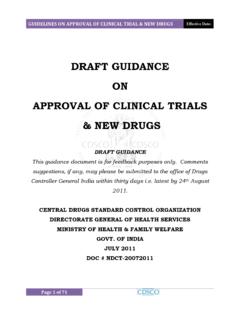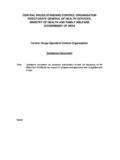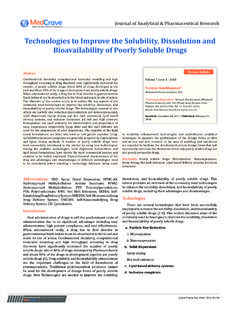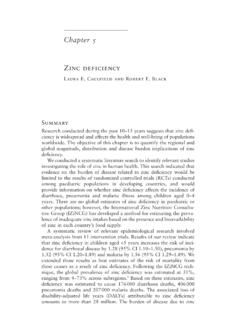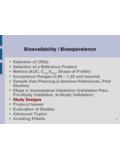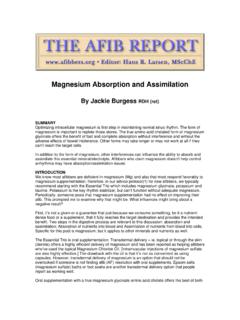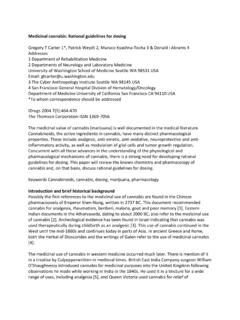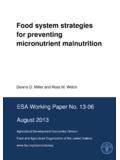Transcription of GUIDELINES FOR BIOAVAILABILITY & …
1 GUIDELINES FOR BIOAVAILABILITY & BIOEQUIVALENCE STUDIES Central Drugs Standard Control Organization, Directorate General of Health Services, Ministry of Health & Family Welfare, Government of India, New Delhi. (March 2005) These GUIDELINES should be read in conjunction with Schedule Y to the Drugs and Cosmetic Rules, GCP GUIDELINES issued by CDSCO, Ministry of Health and Family Welfare, GLP and the Ethical GUIDELINES for Biomedical research on human subjects issued by Indian Council of Medical Research. All provisions described in above documents shall appropriately apply to the conduct of BIOAVAILABILITY and bioequivalence studies. 1 Contents 1. INTRODUCTION 2. DEFINITIONS 3. SCOPE OF THE GUIDELINES When bioequivalence studies are necessary and types of studies required In vivo studies In vitro studies When bioequivalence studies are not necessary 4.
2 DESIGN AND CONDUCT OF STUDIES Pharmacokinetic Studies Study design Study population Study conditions Characteristics to be investigated Bioanalytical methodology Statistical evaluation Special considerations for modified release drug products i Study parameters ii Study design iii Requirements for modified release drug products unlikely to accumulate iv Requirements for modified release drug products likely to accumulate Pharmacodynamic Studies Comparative Clinical Trials In-vitro Studies 5. DOCUMENTATION 6. FACILITIES FOR CONDUCTING BA/BE STUDIES 7. MAINTENANCE OF RECORDS OF BA/BE STUDIES 8. RETENTION OF BA/BE SAMPLES 9. SPECIAL TOPICS Food effect BIOAVAILABILITY studies Long half life drugs Early Exposure Individual and population bioequivalence 31.
3 INTRODUCTION Ensuring uniformity in standards of quality, efficacy and safety of pharmaceutical products is the fundamental responsibility of CDSCO. Reasonable assurance has to be provided that various products, containing same active ingredients, marketed by different licensees, are clinically equivalent and interchangeable. Accordingly, the BIOAVAILABILITY of an active substance from a pharmaceutical product should be known and reproducible. In most cases, it is cumbersome and unnecessary to assess this by clinical studies. BIOAVAILABILITY and bioequivalence data is therefore required to be furnished with applications for new drugs, as required under Schedule Y, depending on the type of application being submitted. Both BIOAVAILABILITY and bioequivalence focus on the release of a drug substance from its dosage form and subsequent absorption into the systemic circulation.
4 For this reason, similar approaches to measuring BIOAVAILABILITY should generally be followed in demonstrating bioequivalence. BIOAVAILABILITY can be generally documented by a systemic exposure profile obtained by measuring drug and/or metabolite concentration in the systemic circulation over time. The systemic exposure profile determined during clinical trials in the early drug development can serve as a benchmark for subsequent BE studies. Bioequivalence studies should be conducted for the comparison of two medicinal products containing the same active substance. The studies should provide an objective means of critically assessing the possibility of alternative use of them. Two products marketed by different licensees, containing same active ingredient(s), must be shown to be therapeutically equivalent to one another in order to be considered interchangeable.
5 Several test methods are available to assess equivalence, including: i comparative BIOAVAILABILITY (bioequivalence) studies, in which the active drug substance or one or more metabolites is measured in an accessible biological fluid such as plasma, blood or urine ii comparative pharmacodynamic studies in humans iii comparative clinical trials iv in-vitro dissolution tests The GUIDELINES describe when BIOAVAILABILITY or bioequivalence studies are necessary and describe requirements for their design, conduct, and evaluation. The possibility of using in vitro instead of in vivo studies with pharmacokinetic end points is also envisaged. 4 For classes of products, including many biologicals such as vaccines, animal sera, and products derived from human blood and plasma, and product manufactured by biotechnology, the concept of interchangeability raises complex which may be addressed by the applicant on the basis of contemporary scientific rationale.
6 In vivo bioequivalence/ BIOAVAILABILITY studies recommended for approval of modified release products should be designed to ensure that i the product meets the modified release label claims ii the product does not release the active drug substance at a rate and extent leading to dose dumping iii there is no significant difference between the performance of the modified release product and the reference product, when given in dosage regimes to arrive at the steady state. iv there must be a significant difference between the performance of modified release product and the conventional release product when used as reference product. It is appreciated that pharmacokinetic studies can be conducted during any phase of a clinical trial for New Chemical Entities (NCEs). While these GUIDELINES deal with pharmacokinetic / pharmacodynamic studies vis- -vis BIOAVAILABILITY or bioequivalence studies for a generic drug, the principles described herein, are applicable for any pharmacokinetic / pharmacodynamic study.
7 52. DEFINITIONS BIOAVAILABILITY BIOAVAILABILITY refers to the relative amount of drug from an administered dosage form which enters the systemic circulation and the rate at which the drug appears in the systemic circulation. BIOEQUIVALENCE Bioequivalence of a drug product is achieved if its extent and rate of absorption are not statistically significantly different from those of the reference product when administered at the same molar dose. CLINICAL TRIAL A clinical trial is a systematic study of pharmaceutical products in human subject(s), in order to discover or verify the clinical, pharmacological (including pharmacodynamic / pharmacokinetic), and/or adverse effects, with the object of determining their safety and/or efficacy. GOOD CLINICAL PRACTICE (GCP) GUIDELINES : Good Clinical Practice GUIDELINES issued by Directorate General of Health Services, Ministry of Health & Family Welfare, Government of India.
8 MODIFIED RELEASE DOSAGE FORMS Modified-release dosage forms are those for which the drug-release characteristics of time course and/or drug-release location are chosen to accomplish such therapeutic or convenience objectives that are not offered by immediate-(conventional) release dosage forms. PHARMACEUTICAL EQUIVALENTS Pharmaceutical equivalents are drug products that contain identical amounts of the identical active drug ingredient, , the same salt or ester of the same therapeutic moiety, in identical dosage forms, but not necessarily containing the same inactive ingredients. PHARMACEUTICAL ALTERNATIVES Pharmaceutical alternatives are drug products that contain the identical therapeutic moiety, or its precursor, but not necessarily in the same amount or dosage form or as the same salt or ester.
9 PHARMACODYNAMIC EVALUATION Pharmacodynamic evaluation is measurement of the effect on a patho-physiological process as a function of time, after administration of two different products to serve as a basis for bioequivalence assessment. 6 PHARMACOKINETICS Pharmacokinetics deals with the changes of drug concentration in the drug product and changes of concentration of a drug and/or its metabolite(s) in the human or animal body following administration of the drug product, , the changes of drug concentration in the different body fluids and tissues in the dynamic system of liberation, absorption, distribution, body storage, binding, metabolism, and excretion. NON-LINEAR PHARMACOKINETICS Nonlinear kinetics or saturation kinetics refers to a change of one or more of the pharmacokinetic parameters during absorption, distribution, metabolism, and excretion by saturation or overloading of processes due to increased dose sizes.
10 REFERENCE PRODUCT For purpose of these GUIDELINES , the reference product is a pharmaceutical product which is identified by the Licensing Authority as Designated Reference Product and contains the same active ingredient(s) as the new drug. The Designated Reference Product will normally be the global innovator s product. An applicant seeking approval to market a generic equivalent must refer to the Designated Reference Product to which all generic versions must be shown to be bioequivalent. For subsequent new drug applications in India the Licensing Authority may, however, approve another Indian product as Designated Reference Product. SUPRA- BIOAVAILABILITY This is a term used when a test product displays an appreciably larger BIOAVAILABILITY than the reference product.
